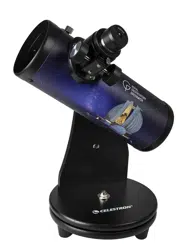Loading ...
Loading ...
Loading ...

10 | ENGLISH
Jupiter and Saturn are, without a doubt, the most beautiful
planets to view in any telescope. We’ll look at them in more detail.
Jupiter is the largest planet in the solar system. It has a very thick
atmosphere of gas, but has no discernible solid surface. When we
view Jupiter, we can only see the outer layers of its atmosphere, but
there are still many wonders to see.
When you look at Jupiter through a telescope, the first thing
you’ll notice is its size. Jupiter is definitely not a star. Even at low
magnification, the planet resolves into a pale tan disk. At higher
magnifications you will see that the disk is not perfectly round; it’s
a little wider in diameter at the equator than measured through
the poles. This is caused by Jupiter’s high rotational speed, taking
just under 10 hours to complete one revolution.
Look carefully at the disk and you will see darker cloud bands
crossing the face of the planet, like stripes on a billiard ball. The
clouds appear as stripes due to different wind conditions at
different latitudes, which can exceed 200 miles per hour (320 km/h). The turbulent areas sandwiched between these
layers can create massive storms that force up layers of compounds from the lower atmosphere, which react with sunlight
to create the red and brown hues seen in the clouds. Since these interactions are constantly changing, Jupiter will look a
bit different each time you view it.
One of the most famous features of Jupiter is the Great Red Spot, a giant storm that is larger than three planet Earths in
diameter and has been going strong since it was first recorded in 1831. Similar to the equatorial cloud bands, the color of
the Great Red Spot can change. For the past few years, the spot has changed from red to a pale salmon pink, making it a
little more difficult for small telescopes to see.
Another fascinating reason to keep your eye on Jupiter is its moons. Jupiter has 67 moons at last count. Unfortunately,
only a handful of them can be seen from Earth. When you view Jupiter through the eyepiece, you will see four small star-
like objects that appear to the right or left of the planet, forming a rough line with Jupiter’s equator. These are the Galilean
moons—Io, Europa, Ganymede and Callisto—first discovered by Galileo Galilei in 1610. They were the first celestial objects
found to orbit a body other than the Earth or the Sun. Three of these moons are larger than Earth’s moon and Ganymede
is even larger than the planet Mercury.
These moons orbit Jupiter very quickly. Io takes less than two days to complete one orbit of Jupiter, while Callisto, with the
longest orbit of the Galilean moons takes almost 17 days. This is much faster than Earth’s moon, which takes close to 28
days to complete one orbit. This means the moons will look different every time you view the planet. Sometimes you will
not be able to see all four moons at the same time as one or more of them may be hidden in the planets shadow or behind
the planet itself. One of the more special treats you might see is a transit of one of the moons or one of the moon shadows
crossing the face of the planet. You can check online for programs that allow you to predict the lunar transits, shadow
transits and eclipses of Jupiter’s moons so you can plan observing sessions around these special events.
OBSERVING JUPITER
Loading ...
Loading ...
Loading ...
